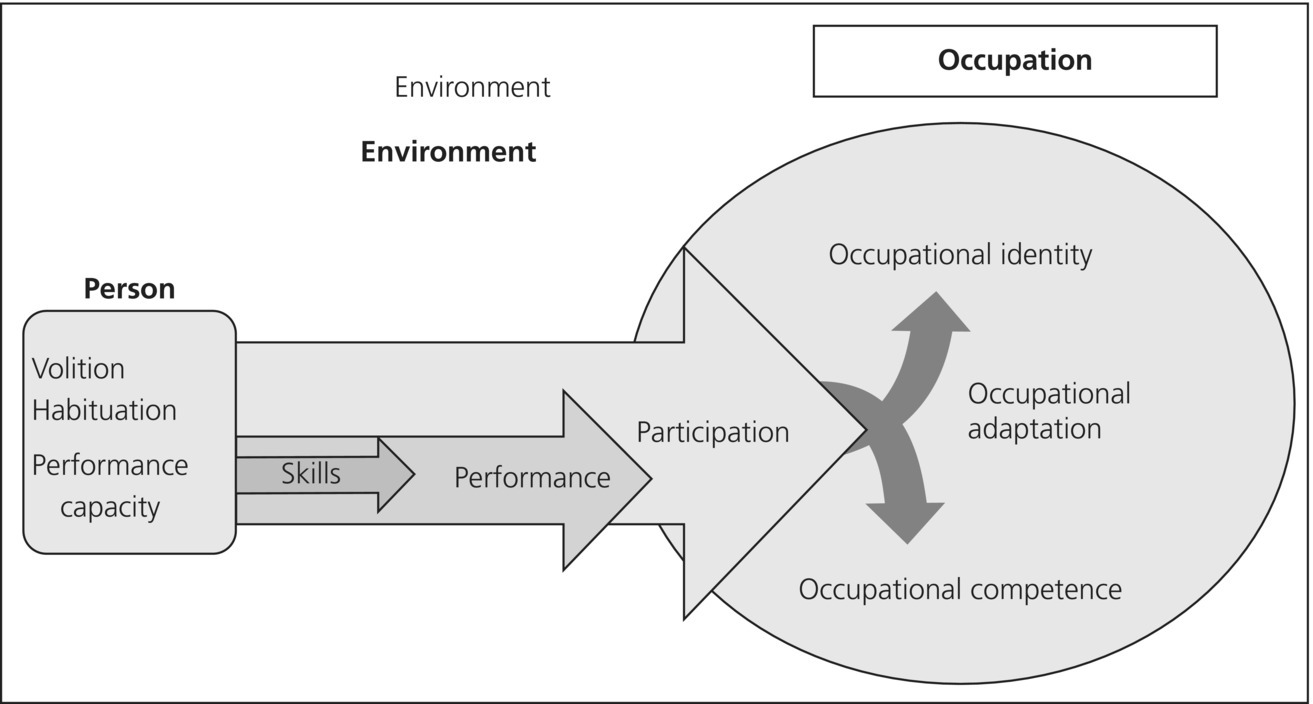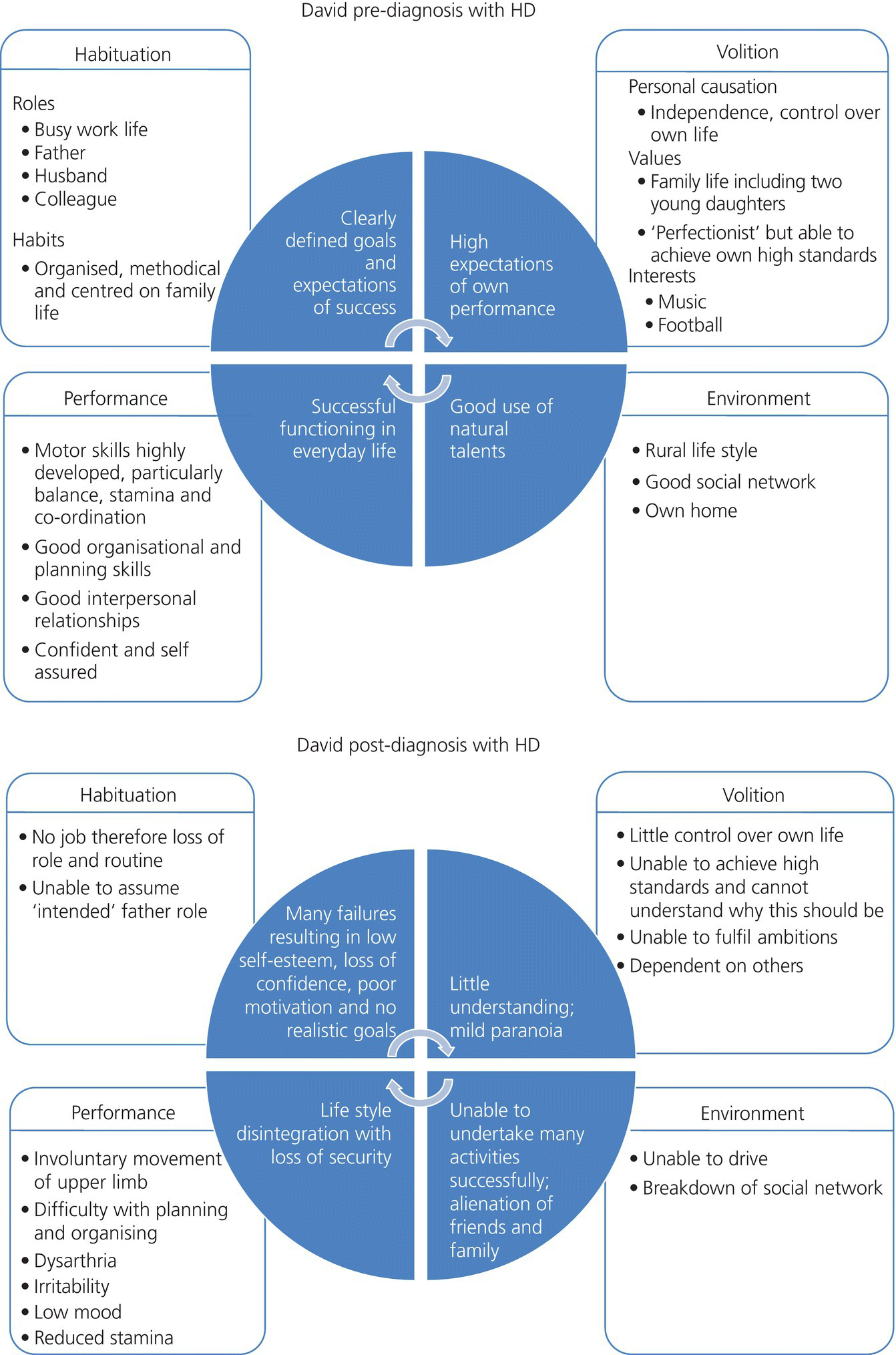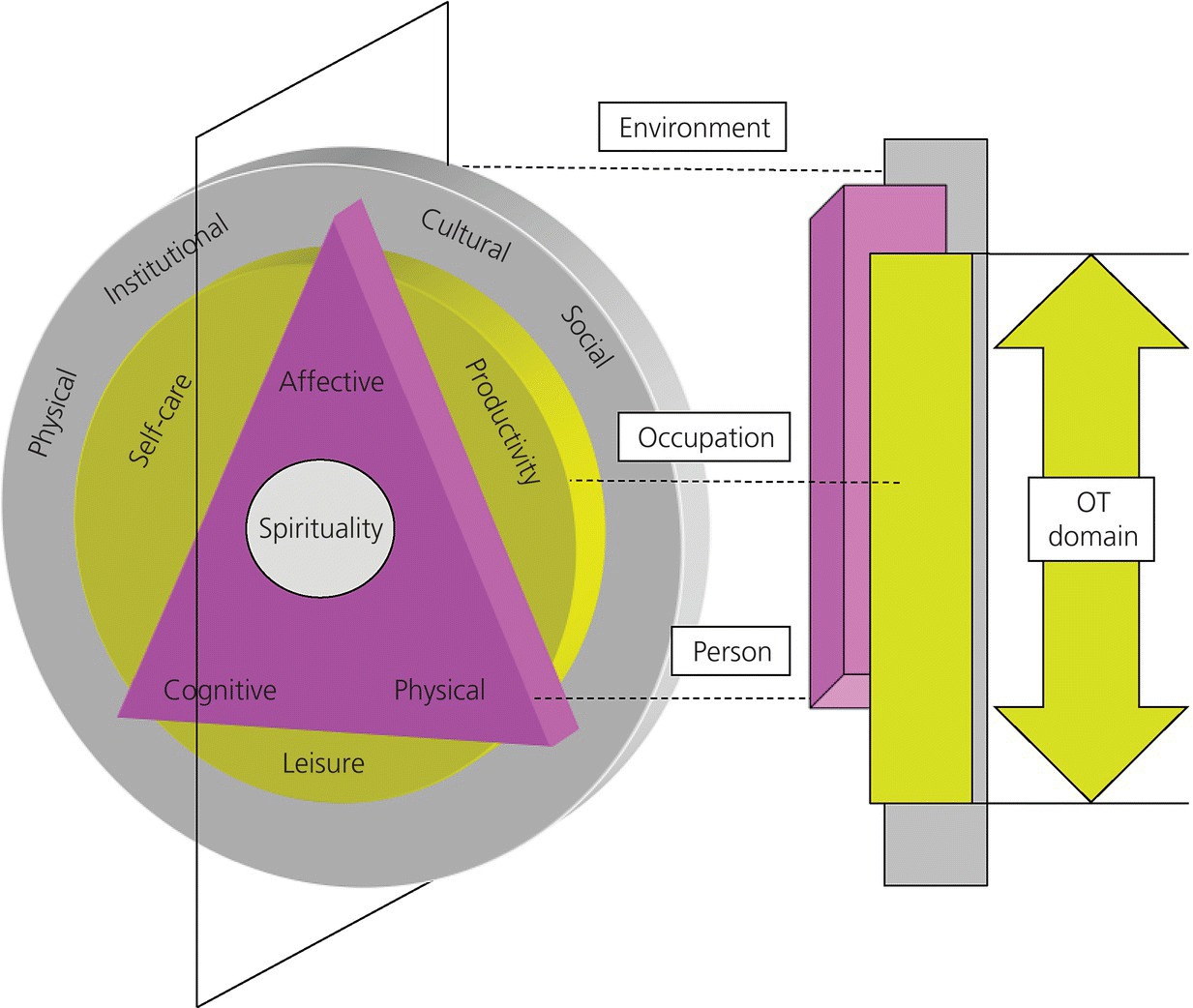CHAPTER 4 Neurological practice is a complex area of occupational therapy practice. Application of the underlying theoretical concepts of occupational therapy can at times seem challenging, particularly within the context of progressive neurological conditions. This chapter explores the relationship between occupational therapy knowledge and core skills and how they can be applied to neurological practice. The content of this chapter will be framed within the model developed by the College of Occupational Therapists (College of Occupational Therapists, 2014; Figure 4.1). Figure 4.1 The relationship between occupational therapy knowledge and core skills. (Source: College of Occupational Therapists 2014, Figure 1, p. 5. Reproduced with permission of College of Occupational Therapists.) A number of definitions of occupational therapy have been developed over the years, but the definition which will be used within the context of this book is that of the College of Occupational Therapists (2009) as follows: Occupational therapists view people as occupational beings. People are intrinsically active and creative, needing to engage in a balanced range of activities in their daily lives in order to maintain health and wellbeing. People shape, and are shaped by, their experiences and interactions with their environments. They create identity and meaning through what they do and have the capacity to transform through pre-meditated and autonomous action. The purpose of occupational therapy is to enable people to fulfil, or to work towards fulfilling, their potential as occupational beings. Occupational therapists promote function, quality of life and the realisation of potential in people who are experiencing occupational deprivation, imbalance or alienation. They believe that activity can be an effective medium for remediating dysfunction, facilitating adaptation and recreating identity. The central philosophy of occupational therapy forms the basis of all practice and is developed from the professional belief in the impact of occupation on health and wellbeing (College of Occupational Therapists, 2014). Health was originally defined by the World Health Organisation in 1948as ‘the state of complete physical, mental and social wellbeing and not merely the absence of disease or infirmity’ and has remained unchanged since then. Reed (2015) challenges the ongoing use of this definition of health as a concept in occupational therapy and the assumption that ‘occupation contributes positively to health’ seeking further advancement of the understanding of the relationship between health and occupation from an occupational perspective. Engagement in meaningful occupations is associated with positive physical health and longevity (Krause, 1991; Krause and Kjorsvig, 1992; Ville et al., 2001); contributes to perceptions of competence, capability, value and enhancing the quality of life itself (Hammell, 2004); and engagement in occupations with and for others generates a sense of belonging that is important to a sense of well-being (Hammell, 2004; Piškur et al., 2002; Waldie, 2002). Specific research involving people with multiple sclerosis (MS) (Reynolds and Prior, 2003) shows that envisioning a future engaged in meaningful occupations contributes to a sense of hope, which is identified as integral to positive well-being (Hammell, 2007). Working with people with long-term neurological conditions, like many other areas of occupational therapy practice, requires high-level thinking and reasoning skills (Bannigan and Moores, 2009). This can involve complex decision making with regards to the following: Occupational therapists are required to draw on scientific knowledge in the form of evidence-based practice, yet there remain many areas in the management of long-term neurological conditions in which strong evidence about the efficacy of interventions is not yet available. In the absence of scientific evidence occupational therapists rely on ‘best’ clinical practice. Professional thinking therefore involves a ‘combination of deliberation, rational thinking, clinical reasoning, professional knowing and expertise gained from previous knowledge’ (Donaghy and Morss, 2000). Critical reflection on one’s practice and clinical reasoning skills can prepare an occupational therapist for all the years of practice as well as for lifelong learning and professional growth (Leicht and Dickerson, 2001). Clinical reasoning may be developed with experience, but experience alone does not guarantee progression through the developmental sequence (Benamy, 1996; Slater and Cohn, 1991). Expert clinical reasoning is a vital skill for occupational therapists in today’s rapidly changing health and social care environments and ‘may be the strongest building block of the profession as it diversifies and grows to meet today’s challenges’ (Leicht and Dickerson, 2001). Clinical reasoning is defined as ‘the thinking processes associated with conducting a clinical practice’ (Unsworth, 2001). Clinical reasoning is the ‘complex thought process occupational therapists use during all therapeutic interactions and is the main process used to integrate client assessment information and formulate an intervention plan’ (Neistadt et al., 1998). Clinical reasoning in occupational therapy practice has been found to differ from medical and nursing primarily due to the emphasis on the individual aspects of the client and their future occupational possibilities as opposed to the more immediate presenting medical problems (Leicht and Dickerson, 2001). Mattingly and Fleming (1994) acknowledged that occupational therapists focus on the meaning for the client, while the medical profession focuses on obtaining a diagnosis in order to cure disease and prevent death of the client (Leicht and Dickerson, 2001). Furthermore occupational therapists are found to clinically reason throughout the treatment process and not solely at the assessment phase (Schell and Cervero, 1993). Occupational therapists engage in a range of forms of clinical reasoning which can include the following: Diagnostic reasoning is defined as a series of cognitive operations the occupational therapist performs to formulate the occupational therapy ‘diagnosis’. This occurs within a two-phase process which focuses on problem identification and formulation of an intervention plan (Leicht and Dickerson, 2001). Key factors which support this process include the client’s medical diagnosis, reason for referral, client’s goals, targeted discharge environment, client’s demographic characteristics, practice setting and the therapist’s frame of reference (Rogers and Holm, 1997). The information obtained through this process is then used to formulate a hypothesis about occupational performance which can be refined and discarded as further information becomes available through relevant assessments and data collection. This pattern of occupational dysfunction is then compared to the occupational therapists prior knowledge and experience to inform a diagnostic statement or problem identification (Leicht and Dickerson, 2001). Procedural reasoning places emphasis on the client’s dysfunction and what procedures may alleviate the problem or remediate the client’s functional performance problems (Mattingly and Fleming, 1994). In this form of reasoning the emphasis is on the ‘process of defining the client’s diagnostically related occupational performance area, performance component, and performance context problems, and selecting appropriate interventions’ (Leicht and Dickerson, 2001). Fleming (1991a) views procedural reasoning in occupational therapy as the product of working within a medical model of care and compares this form of problem solving with the process of diagnosis, prognosis and prescription commonly used by physicians. Interactive reasoning is used to help therapists interact and better understand the client (Leicht and Dickerson, 2001). Interactive reasoning leads to an understanding of what the disease or disability means to the client. Occupational therapists use interactive reasoning to develop an impression of the client as a person and his/her needs, interests and attitudes and then use this to obtain client collaboration in the therapy process and is used to experience the disability from the client’s perspective (Leicht and Dickerson, 2001). Schwartz (1991) argues for a strong commitment to the caring perspective within occupational therapy, which is concerned predominantly with people and their relationships, in contrast to the justice perspective in which truth, justice and equality are the guiding principles. Occupational therapists emphasise the need for a strong therapeutic relationship for the therapeutic process to be successful (Mattingly, 1991a; Schwartz, 1991). Additionally occupational therapists ‘use interactive reasoning to engage or motivate the client in the treatment session, and to match treatment goals and strategies with the client’s interests and wishes. Interactive reasoning is also used to determine if the treatment session is going well and to construct a shared language for therapy between the therapist and the client’ (Leicht and Dickerson, 2001). Interactive reasoning can also be used to convey a sense of trust, acceptance and hope to the client through the use of humour to relieve tension (Alnervik and Sviden, 1996; Fleming, 1991a). Conditional reasoning is a ‘complex form of social reasoning that is used to help the client participate in the difficult process of reconstructing his/her life after a permanent change due to an illness or injury’ (Mattingly and Fleming, 1994). Conditional reasoning embodies the holistic perspective of the person’s situation and is dependent on the participation of both the client and the therapist (Fleming, 1991a). Within this process occupational therapists need empathy and an ability to imagine how a client’s condition could change using both current and future contexts, involving the client in the construction of an image of the possible outcome (Neistadt, 1998). Conditional reasoning is a complex multi-dimensional process that does not follow a strictly logical sequence, is not strictly cognitive, and is not always a conscious process (Fleming, 1991b; Mattingly and Fleming, 1994). In conditional reasoning the occupational therapist is attempting to integrate both the procedural and interactive reasoning components into one and then moving this focus onto the future of the client (Alnervik and Sviden, 1996; Fleming, 1991b). Narrative reasoning is fundamental to occupational therapy as it ‘seeks to make sense of the reality by linking the outside world to the inner world of intention and motivation’ (Mattingly, 1991b). While the emphasis on the disease or diagnosis is fundamental in other models of reasoning the focus of narrative reasoning is undoubtedly on the client’s experience of the disease and how that interacts with the person’s life story (Mattingly, 1991b). The skill of the occupational therapist lies in the ability to ‘put it all together’ (Leicht and Dickerson, 2001). Narrative reasoning is central to the occupational therapy process and involves viewing therapy as a chapter in the client’s life story. Narrative reasoning includes not only telling the retrospective life story but also involving the client in prospective story building (Leicht and Dickerson, 2001). Scientific reasoning is one of four facets of clinical reasoning defined by Schell and Cervero (1993). Scientific reasoning is described as ‘a framework for the understanding of the condition affecting the individual and determining the appropriate treatment interventions’ (Schell, 1998). Diagnostic reasoning and procedural reasoning are considered the two forms of scientific reasoning (Schell, 1998). Pragmatic reasoning is the second facet defined by Schell and Cervero (1993) and considers all practical issues that affect occupational therapy services, such as treatment environment; the therapists’ values, knowledge, abilities and experiences; the client’s social and financial resources; and the client’s potential discharge environment (Neistadt, 1998). Pragmatic reasoning allows the therapist to decide what can be done for a particular client in a given treatment setting (Neistadt et al., 1998) and addresses the practical realities associated with service delivery in the present health and social care environments (Schell, 1998). While pragmatic reasoning is thought to have positive effects on the therapeutic process, overemphasis on pragmatic reasoning may not allow for individualisation (Leicht and Dickerson, 2001). Ethical reasoning is strongly related to the therapists’ values and as such has some parallels with Fleming’s (1991b) ethical and moral decision-making. The emphasis within this facet is on the aspects of ethical reasoning by focussing not on ‘what could be done’ in a therapy session, but ‘should be done’ reflecting the competing challenges of service delivery, client preferences and possible treatment options (Leicht and Dickerson, 2001). Occupational therapists rely on conceptual models of practice to provide the language and tools to help define the problems, develop effective interventions and evaluate the impact. The following key conceptual models of practice can be applied to neurological practice: The MOHO is defined as a ‘client-centred, occupation-focussed, evidence-based conceptual model of practice which embraces the complexity of people’s occupational needs’ (Forsyth and Kielhofner, 2011). Within this model there is recognition that human occupation is complex, context-dependent and that occupations shape a person’s self-perception and identity. Fundamental to the MOHO (Figure 4.2) are the concepts of : Figure 4.2 The Model of Human Occupation (MOHO). (Source: Christiansen et al. 2015, Figure 3-6, p. 35. Reproduced with permission of Slack Incorporated.) Figure 4.3 illustrates how MOHO can be applied. Figure 4.3 Illustration of MOHO applied to neurological practice. Within this model, Townsend and Polatajko (2007) conceptualise occupational performance as the ‘dynamic interaction of person, occupation, and environment’. The person is considered within the context of spiritual, physical, affective and cognitive components (Figure 4.4). Occupation is defined within self-care, productivity and leisure. This social model includes the cultural, physical and social environments encompassing the economic, legal and political environments. The physical environment provides a contextual model to identify barriers and enablers to participation, while the social environment reflects the importance of roles and relationships. The inclusion of the institutional environment incorporates factors which can contribute to the identification of occupational deprivation and occupational injustice. The main tool associated with this model, the Canadian Occupational Performance Measure (COPM) will also be discussed in Chapter 6. Figure 4.4 The Canadian Model of Occupational Performance and Enablement (CMOP-E). (Source: Turpin and Iwama 2011, Figure 5.1, p. 118. Reproduced with permission of Churchill Livingstone Elsevier, Toronto.)
Theoretical basis
4.1 Introduction

4.2 Definitions of occupational therapy
4.3 Central philosophy of occupational therapy
4.4 Core professional reasoning skills
4.4.1 Clinical reasoning
4.5 Conceptual models of occupational therapy practice
4.5.1 Model of Human Occupation


4.5.2 Canadian Model of Occupational Performance and Enablement

Stay updated, free articles. Join our Telegram channel

Full access? Get Clinical Tree





